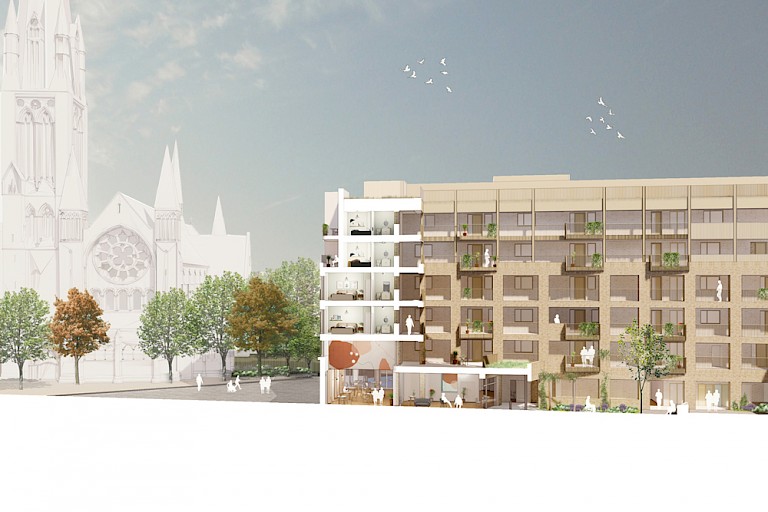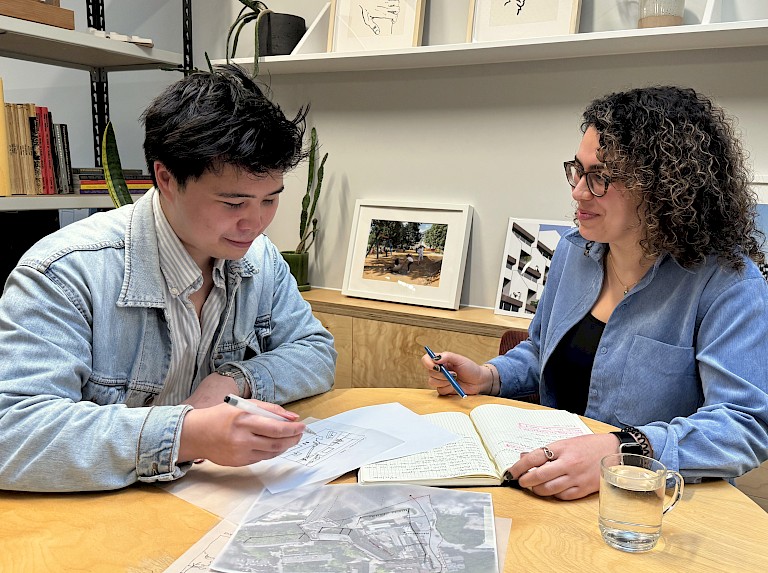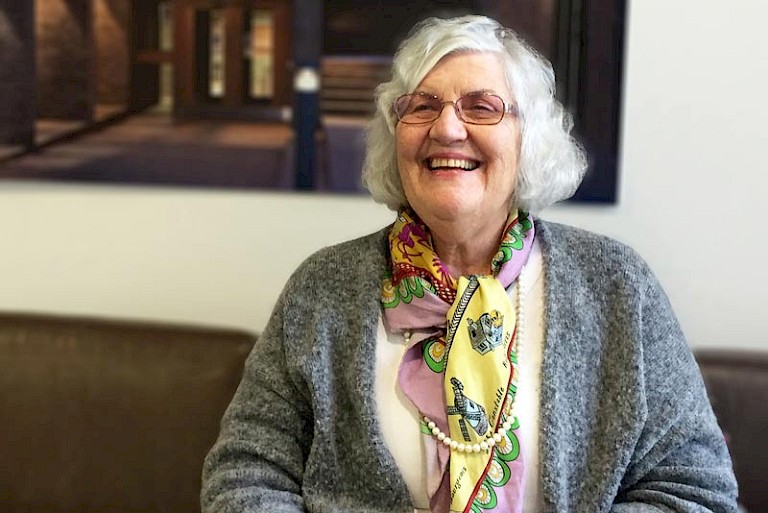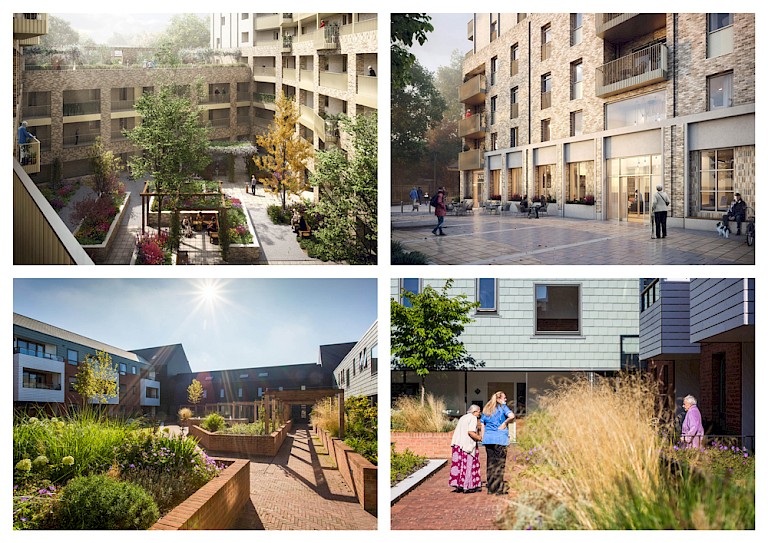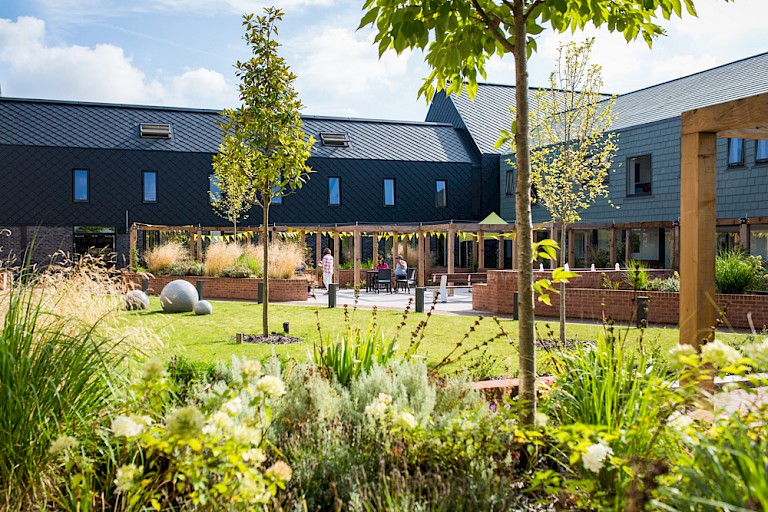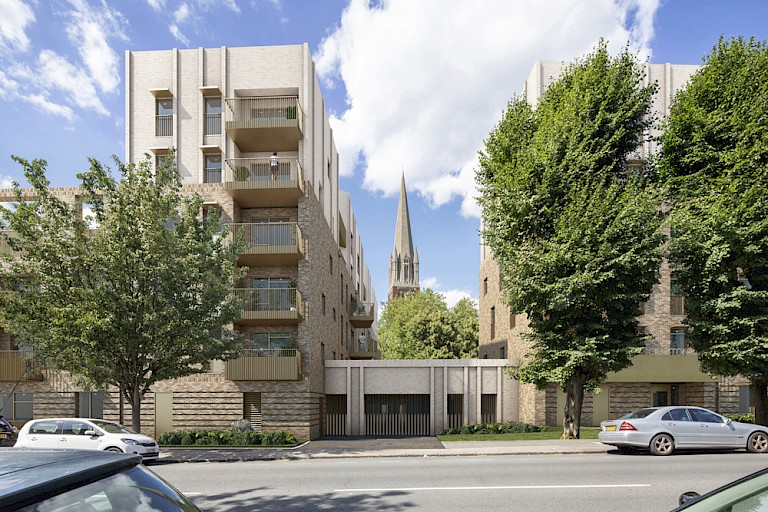
Planning permission has been awarded to Westminster City Council’s flagship extra care and general needs scheme. We designed Carlton Dene alongside RPS, eb7, CRE8 Structures and Etude. It will provide 65 extra care homes for older people and 22 family-sized apartments for affordable rent in South Kilburn in Westminster.
The scheme is targeting an ambitious sustainability brief, seeking Passivhaus accreditation for the general needs homes and the PHI low energy building standard for the extra care building. The new development will maintain existing heritage views (shown above) towards the nearby Grade I listed church’s spire, both through the site and along Kilburn Park Road.
A community-facing café will form the heart of the extra care ground floor. Placed at the front of the building, alongside other activity spaces, it will draw in local people to use the facilities without compromising the privacy and security of residents. The complex also includes a Changing Places facility and meeting space that will be available to local organisations. Opening up selected facilities to the wider community will enable residents to make and maintain local social links as well as adding to local services.
The scheme is linked to separate future plans to transform what is currently a rear service entrance into an active frontage which will define a new civic space to be shared by the church and the entrance to the extra care apartments and new public café. This space will tie in to proposals which are being developed across the road as part of the South Kilburn Masterplan.
Cllr Heather Acton, Westminster City Council Cabinet Member for Communities and Regeneration, said: “We’re committed to building affordable homes for people at all stages of their lives and this is another exciting milestone. Extra care housing offers older people a chance to live somewhere with flexible care which is tailored to their individual needs. In addition, the 22 spacious family-sized homes available at social and intermediate rent are much needed in the area and will be available for existing and new residents to move in to. We ran an extensive consultation process to ensure residents had the opportunity to view and comment on the proposals and I’m extremely pleased we can now progress with our plans.”
The extra care accommodation incorporates an important degree of flexibility to respond to the changing needs of older people, so that they can ‘age in place’ even as mobility reduces or cognitive impairment increases. Older people are also likely to spend more time inside their homes than the general population and so we focused on light and airy interiors that maximise views outside that the residents will enjoy. Many of the extra care homes are a ‘one-bed-plus’ model, with flexible partitions that provide different layout configurations based on residents' requirements. For example, the adaptable ‘study space’ can be opened up to part of the lounge or removed altogether to create a larger bedroom.
The scheme adheres to best practice in dementia design, such as using simple home layouts and prioritising views and visual connections to external spaces. Communal balconies overlooking the generous courtyard and roof terrace spaces provide additional shared spaces outside front doors, in line with Housing our Ageing Population: Panel for Innovation (HAPPI) principles.
Learning from the success of our previous built schemes, including the award-winning Hazelhurst Court, homes in the extra care building are accessed from open decks on the courtyard side; here, residents will be able to ‘extend’ their homes by providing areas to sit or grow plants. The opportunity to personalise spaces outside front doors will add a sense of homeliness and community by encouraging incidental social interaction, as well as assist with wayfinding.
A series of carefully landscaped outdoor spaces will be provided for residents, including sheltered roof terraces and a central courtyard that will be accessed directly from communal spaces and ground floor apartments. The courtyard will support residents with early onset dementia in particular, providing a comfortable outdoor environment that stimulates the senses and provides mental and physical wellbeing benefits.
All homes are dual aspect to increase daylight and encourage the use of natural ventilation. Fixed solar shading on the southern façades and moveable external louvres to the west will also help reduce higher temperatures. All new homes will have a level-access private balcony or terrace.
The general needs housing provides a mix of one, two and three bedroom affordable rented apartments. The larger family homes can accommodate up to five people. This building benefits from a primary outlook to the south and east over the adjacent green space, putting front doors on to the well-used path between Carlton Vale and the church.
